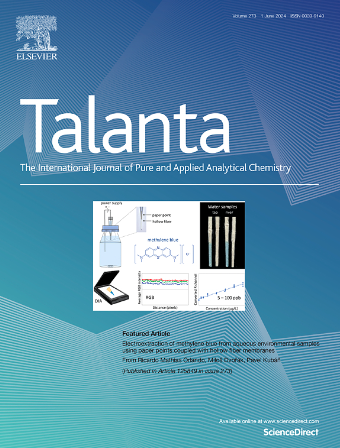Eco-sustainable point-of-care devices: Progress in paper and fabric based electrochemical and colorimetric biosensors
IF 5.6
1区 化学
Q1 CHEMISTRY, ANALYTICAL
引用次数: 0
Abstract
Monitoring real-time health conditions is a rinsing demand in a pandemic prone era. Wearable Point-of-Care (POC) devices with paper and fabric-based sensors are emerging as simple, low-cost, portable, and disposable analytical tools for development of green POC devices (GPOCDs). Capabilities of passive fluid transportation, compatibility with biochemical analytes, disposability and high degree of tunability using vivid device fabrication strategies enables development of highly sensitive and economically feasible POC sensors in particularly post COVID-19 pandemic outbreak. Herein we focus mainly on development of biosensors for testing body fluids in the last 5 years using microfluidic technique through electrochemical and colorimetric principle which forms the two most competing sensing techniques providing quantitative and qualitative assessment modalities respectively and forms almost 80 % of the diagnostic platform worldwide. Present review highlights use of these popular substrates as well as various fabrication strategies for realization of GPOCDs ranging from costly and highly sophisticated photolithography to low cost, non conventional techniques like use of correction ink or marker based devices to even novel pop-up/origami induced patterning techniques. Insights into the advancements in colorimetric technique like distance, count or even text based semi-quantitative read-out modality as a on-hand diagnostic information has also been provided. Finally, future outlooks with other interdisciplinary modalities like use of novel materials, incorporation of digital tools like artificial intelligence (AI), machine learning (ML) and strategies for sensitivity and reliability improvement of future GPOCDs have also been discussed.

生态可持续护理点设备:基于电化学和比色生物传感器的纸和织物的进展。
在大流行易发时代,实时监测卫生状况的需求日益增加。基于纸张和织物的传感器的可穿戴式医疗点(POC)设备正在成为一种简单、低成本、便携式和一次性的分析工具,用于开发绿色POC设备(gpocd)。被动流体输送能力、与生化分析物的相容性、可丢弃性和高度可调性,利用鲜艳的设备制造策略,使高灵敏度和经济上可行的POC传感器得以开发,特别是在COVID-19大流行爆发后。在这里,我们主要关注在过去的5年中利用微流体技术通过电化学和比色原理开发用于检测体液的生物传感器,这是两种最具竞争力的传感技术,分别提供定量和定性评估模式,占全球诊断平台的近80%。目前的综述强调了这些流行的基材的使用以及实现gpocd的各种制造策略,从昂贵和高度复杂的光刻到低成本的非传统技术,如使用校正墨水或基于标记的设备,甚至是新颖的弹出/折纸诱导图案技术。还提供了对比色技术的进步的见解,如距离,计数甚至基于文本的半定量读出模式作为手边的诊断信息。最后,还讨论了其他跨学科模式的未来前景,如使用新材料,结合人工智能(AI)、机器学习(ML)等数字工具,以及提高未来gpocd的灵敏度和可靠性的策略。
本文章由计算机程序翻译,如有差异,请以英文原文为准。
求助全文
约1分钟内获得全文
求助全文
来源期刊

Talanta
化学-分析化学
CiteScore
12.30
自引率
4.90%
发文量
861
审稿时长
29 days
期刊介绍:
Talanta provides a forum for the publication of original research papers, short communications, and critical reviews in all branches of pure and applied analytical chemistry. Papers are evaluated based on established guidelines, including the fundamental nature of the study, scientific novelty, substantial improvement or advantage over existing technology or methods, and demonstrated analytical applicability. Original research papers on fundamental studies, and on novel sensor and instrumentation developments, are encouraged. Novel or improved applications in areas such as clinical and biological chemistry, environmental analysis, geochemistry, materials science and engineering, and analytical platforms for omics development are welcome.
Analytical performance of methods should be determined, including interference and matrix effects, and methods should be validated by comparison with a standard method, or analysis of a certified reference material. Simple spiking recoveries may not be sufficient. The developed method should especially comprise information on selectivity, sensitivity, detection limits, accuracy, and reliability. However, applying official validation or robustness studies to a routine method or technique does not necessarily constitute novelty. Proper statistical treatment of the data should be provided. Relevant literature should be cited, including related publications by the authors, and authors should discuss how their proposed methodology compares with previously reported methods.
 求助内容:
求助内容: 应助结果提醒方式:
应助结果提醒方式:


